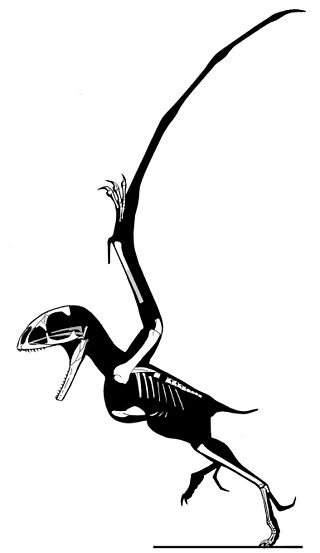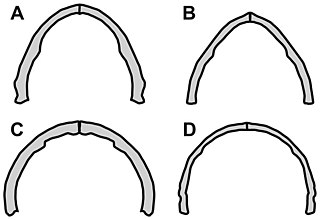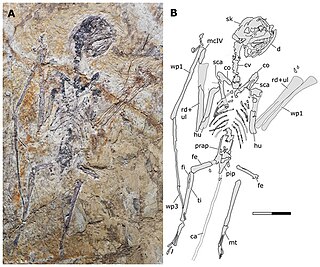Related Research Articles

Scarification involves scratching, etching, burning/branding, or superficially cutting designs, pictures, or words into the skin as a permanent body modification or body art. The body modification can take roughly 6–12 months to heal. In the process of body scarification, scars are purposely formed by cutting or branding the skin by various methods. Scarification is sometimes called cicatrization.

Jeholopterus was a small anurognathid pterosaur from the Middle to Late Jurassic Daohugou Beds of the Tiaojishan Formation of Inner Mongolia, China, preserved with hair-like pycnofibres and skin remains.

Dimorphodon was a genus of medium-sized pterosaur from the early Jurassic Period. It was named by paleontologist Richard Owen in 1859. Dimorphodon means "two-form tooth", derived from the Greek δι meaning "two", μορφη meaning "shape" and οδων meaning "tooth", referring to the fact that it had two distinct types of teeth in its jaws – which is comparatively rare among reptiles. Dimorphodon inhabited Europe.

Tanga Region is one of Tanzania's 31 administrative regions. The region covers an area of 26,667 km2 (10,296 sq mi). The region is comparable in size to the combined land area of the nation state of Burundi. The regional capital is the municipality of Tanga city. Located in northeast Tanzania, the region is bordered by Kenya and Kilimanjaro Region to the north; Manyara Region to the west; and Morogoro and Pwani Regions to the south. It has a coastline to the east with the Indian Ocean. According to the 2012 national census, the region had a population of 2,045,205.

Anurognathus is a genus of small pterosaur that lived during the Late Jurassic period. Anurognathus was first named and described by Ludwig Döderlein in 1923. The type species is Anurognathus ammoni. The genus name Anurognathus is derived from the Greek αν/ an- ("without"), оυρα/ oura ("tail"), and γναθος/ gnathos ("jaw") in reference to its unusually small tail relative to other "rhamphorhynchoid" pterosaurs. The specific name ammoni honours the Bavarian geologist Ludwig von Ammon, from whose collection Döderlein had acquired the fossil in 1922.

The Amboni Caves are a limestone cave complex in East Africa. They are located 8 km north of Tanga City in Tanzania off the Tanga-Mombasa road. The reported length of the longest cave is 755m. The caves were formed about 150 million years ago during the Jurassic age. It covers an area of 234 km². According to researchers the area was under water some 20 million years ago. There are altogether ten caves but only one is used for guided tours.

Batrachognathus is an extinct genus of anurognathid pterosaur from the Late Jurassic Karabastau Formation of the central Asian republic of Kazakhstan. The genus was named in 1948 by the Russian paleontologist Anatoly Nicolaevich Ryabinin. The type species is Batrachognathus volans. The genus name is derived from Greek batrakhos, "frog" and gnathos, "jaw", in reference to the short wide head. The specific epithet means "flying" in Latin.
The Zigula or Zigua are a Bantu ethnic and linguistic people hailing from far northern Pwani Region and western southern Tanga Region. In Tanga Region they are the majority in Handeni District, northern Kilindi District and also a historically significant population in south of the Pangani River in Pangani District. They speak the Zigula language. In 1993, the Zigua population was estimated to number 355,000 people.

The Shambaa people, also called the Sambaa, Shambala, Sambala or Sambara, are a Bantu ethnic group. Their ancestral home is on the Usambara Mountains of Lushoto District, Bumbuli District. They are native to the valleys and eastern Usambara Mountains of Korogwe District, Korogwe Urban District and western Muheza District of northern Tanga Region of Tanzania. The word Shamba means "farm", and these people live in one of the most fertile Tanzanian region. In 2001, the Shambaa population was estimated to number 664,000.
The Bondei People are a Bantu ethnic group based in Pangani District in east Tanga Region in northeastern Tanzania. Bondei speak a Bantu language and are related to the Shambaa ethnic group.
G24 may refer to:
The Northeast Coast Bantu languages are the Bantu languages spoken along the coast of Tanzania and Kenya, and including inland Tanzania as far as Dodoma. In Guthrie's geographic classification, they fall within Bantu zones G and E.

The Tiaojishan Formation is a geological formation in Hebei and Liaoning, People's Republic of China, dating to the middle-late Jurassic period. It is known for its exceptionally preserved fossils, including those of plants, insects and vertebrates. It is made up mainly of pyroclastic rock interspersed with basic volcanic and sedimentary rocks. Previously, the Tiaojishan Formation was grouped together with the underlying Haifanggou Formation as a single "Lanqi Formation." The Tiaojishan Formation forms a key part of the Yanliao Biota assemblage, alongside the Haifanggou Formation.
Erasto Andrew Mbwana Mang'enya was a Tanganyikan/Tanzanian diplomat and politician.

Vesperopterylus is a genus of anurognathid pterosaur from the Early Cretaceous Jiufotang Formation of China, the geologically youngest member of its group. Notably, Vesperopterylus appears to have a reversed first toe, which would have been suited for gripping; it was likely arboreal, climbing or clinging to tree branches with curved, sharp claws. It also has a relatively short tail, in contrast with its tailless (Jeholopterus) and long-tailed (Dendrorhynchoides) relatives. It was first described and named by Lü Junchang et al. While the original spelling of the name was Versperopterylus, this was a typo, and was emended by the authors in accordance with the International Code of Zoological Nomenclature.
Luopterus is an extinct genus of anurognathid pterosaur containing only the holotype species L. mutoudengensis that is known from the Middle Jurassic Tiaojishan Formation of Qinglong, northern Hebei Province, China. It was originally named as a species of Dendrorhynchoides in 2012 but it was moved to the genus Luopterus in 2020. Luopterus was originally thought to be from the Early Cretaceous, with a wingspan that is about 40 centimeters (16 in), making it one of the smallest known pterosaurs.

Sinomacrops is a genus of extinct anurognathid pterosaur from the Middle to Late Jurassic periods of what is now the Daohugou Beds of the Tiaojishan Formation in Mutoudeng, Qinglong County of the Hebei province. The remains of Sinomacrops date back to around 164 to 158 million years ago. The type and only known species is Sinomacrops bondei.
Vugha or Vuga is historic village located inside Bumbuli District of Tanga Region in Tanzania. The settlement was established as the capital of the Kilindi dynasty.
Cascocauda is an extinct genus of anurognathid pterosaur from the Late–Middle Jurassic Tiaojishan Formation of Hebei Province, China. The genus contains a single species, C. rong, known from a complete skeleton belonging to a juvenile individual preserved with extensive soft-tissues, including wing membranes and a dense covering of pycnofibres. Some of these pycnofibres appear to be branched, resembling the feathers of maniraptoran theropod dinosaurs, and suggesting that pterosaur pycnofibres may be closely related to feathers in dinosaurs.
References
- ↑ Bondei at Ethnologue (18th ed., 2015) (subscription required)
- ↑ Jouni Filip Maho, 2009. New Updated Guthrie List Online